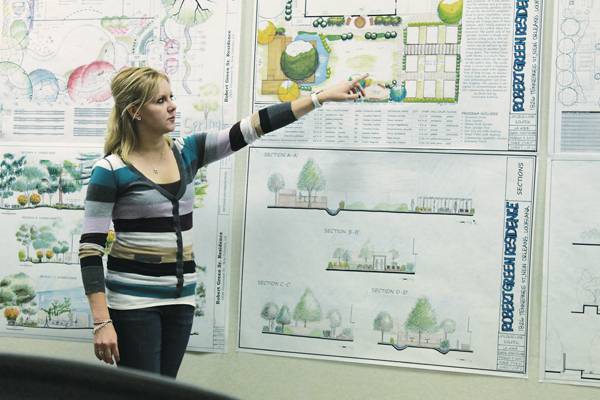ISU Students make a difference

Jackie Kolpek, senior in landscape architecture, presents her design of a memorial garden for Robert Green, New Orleans, whose family was killed in the floods of Hurricane Katrina. Green visited Professor Gary Hightshoe’s class Tuesday, March. Photo: Erin Oftelie/Iowa State Daily
March 11, 2010
A class of third-year landscape architecture students who are creating a memorial garden for a New Orleans man held a review of their progress in the College of Design on Tuesday. Robert Green Sr., of New Orleans’ Lower 9th Ward, lost his mother and granddaughter in the flooding during Hurricane Katrina.
The project began last fall when Gary Hightshoe, professor of landscape architecture, along with fellow professors Mira Engler and Tim Keller, took a group of second-year landscape architecture students on a six-week Savanna traveling studio, during which they stopped in New Orleans. It was there that the class met Green, and he shared his story of devastation and loss.
Hightshoe said the main reason for the traveling studio is to “meet people and hear their stories, talk with professional landscape architects, and better understand the role of landscape architecture as it attempts to conserve and help communities plan for the future.”
Green and the class’s correspondence until this point has been via videoconferences, but Green traveled to Ames to see the review in person.
“I thought it would mean more to come up here to see it… to show [the students] we appreciate it, and we’re going to make it happen,” Green said.
Green said he feels it is important for the students to understand how important the project is to him. “If it hadn’t been for the students here, we wouldn’t be going to the next step of implementation,” he said.
Hightshoe said the Savanna traveling studio is something each second-year class does, and it is the only one of its kind in any landscape architecture program in the nation.
“It was upon seeing and becoming inspired by the student drawings of his home that he shared his desire to create a beautiful garden on the adjacent vacant lot, in memory of his granddaughter,” Hightshoe wrote in a description of the project. “He invited the students to help him envision the garden possibilities. Toward this end, our class accepts his invitation.”
While it was the second-year landscape architecture students who conceptualized the project, Hightshoe said the third-year students are pursuing it because “the third-year students are more advanced, and have more design experience, so it seemed like a good fit,” he said.
Green’s home was destroyed when the hurricane hit land, causing a 20-foot-high tsunami to flood the ward, destroying more than 4,000 homes.
Two years later, actor Brad Pitt toured the ward, and ensured the families he spoke to that he would do what he could do help. He later founded Make it Right, a nonprofit organization that aims to help “residents of New Orleans’ Lower 9th Ward rebuild their lives and community in the wake of Hurricane Katrina… to bring at least 150 families home to affordable, green storm resistant houses,” according to the organization’s Web site.
One of the first homes to be built was Green’s.






